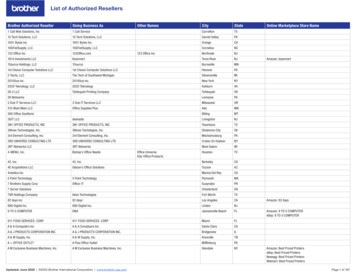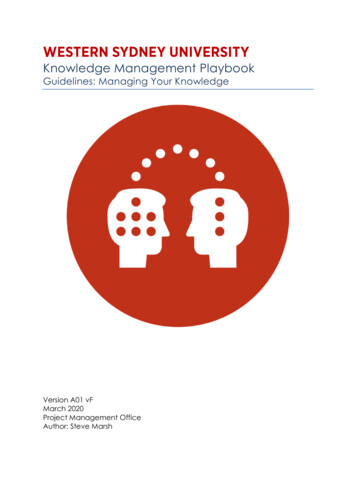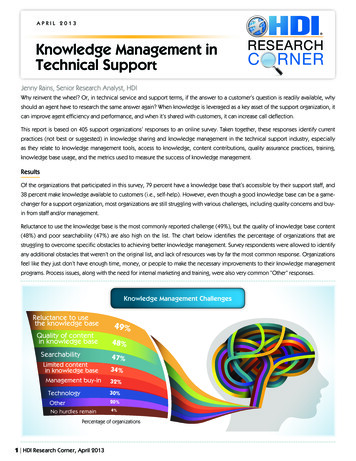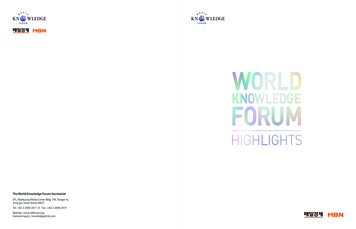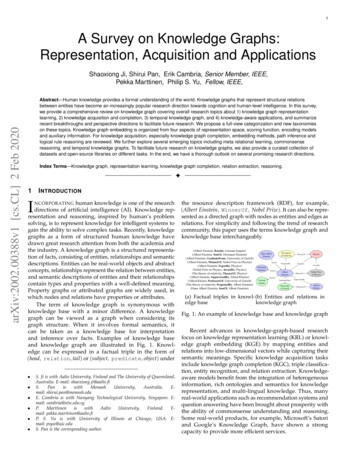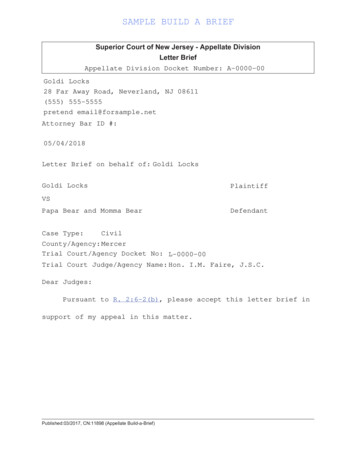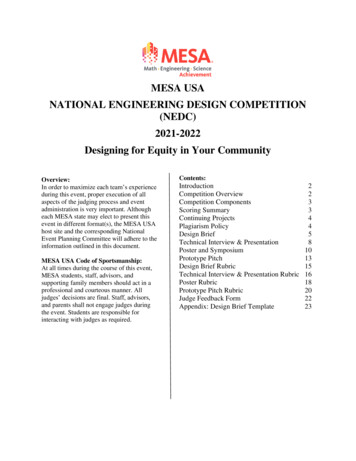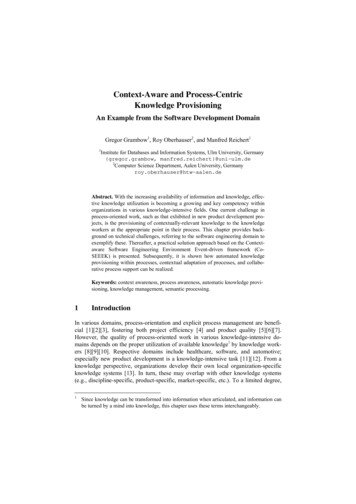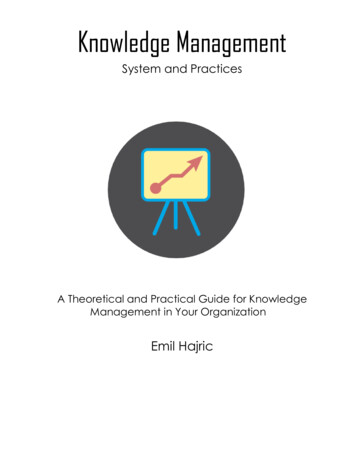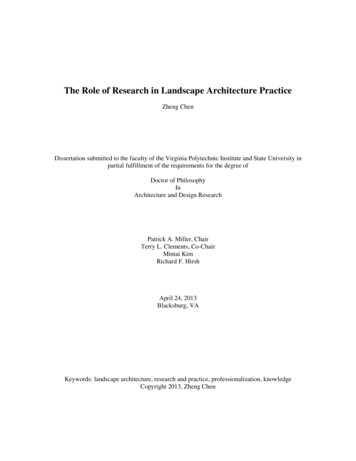
Transcription
GLOBAL KNOWLEDGE BRIEFInternal Audit in a Post-COVID WorldPart 1: Talent Management1 — theiia.org
ContentsIntroduction . 4Redefining work . 4Evolving Employee Expectations . 5Flexibility is key to work-life balance . 5Internal Audit Mirrors Survey Findings . 6Overcoming attrition is a priority . 6Technology and Talent . 8Adding urgency to a familiar challenge. 8Diversity, Equity, and Inclusion . 9Flexibility includes corporate culture, DEI . 9Conclusion .112 — theiia.org
About the ExpertsEric Wilson, CIA, CISAEric Wilson is the Director of Internal Audit and CAE for Gulfport Energy, overseeing all aspects of the company’s audit work andidentifying and fostering opportunities for internal audit to consult across the organization. Prior to joining Gulfport Energy, Ericheld multiple leadership positions at Chesapeake Energy, including a multi-year rotation through Chesapeake’s commoditymarketing group. Eric was responsible for overseeing and enhancing the group’s operational and financial planning processes,compliance activities, and technology capabilities. He also led internal audit and consulting teams for various domestic andinternational companies in a wide range of industries, including energy, commercial real estate, and healthcare, among others.Eric has served on The Institute of Internal Auditors (IIA) Professional Knowledge, Advocacy, and Content Advisory boards; andhe is a member of the Board of Governors for The IIA Oklahoma City Chapter. He also is an elected member of the University ofOklahoma’s Steed School of Accounting Board of Advisors. In addition to holding Certified Internal Auditor (CIA) and CertifiedInformation Systems Auditor (CISA) certifications, Eric has attained his Lean Six Sigma Black Belt.Uday Gulvadi, CIA, CPA, CAMS, CISAUday Gulvadi is a Director in the Disputes, Compliance, and Investigations group at Stout. He also co-leads Stout’s RegulatoryCompliance and Financial Crimes practice. Uday is a recognized industry leader and a board member and past president of TheInstitute of Internal Auditors (IIA) New York Chapter. He is a frequent speaker at national and international conferences,workshops, and professional events and has authored thought leadership publications in anti-money laundering, financial crimescompliance and sanctions, governance, regulatory compliance, internal audit, enterprise risk, and information technology risksand controls. Uday has led board and C-suite compliance training and workshops for international banks.Uday has held partner and director positions within the internal audit and risk management practices at leading national andregional accounting and advisory firms. He specializes in advising boards, audit committees, and senior management on variedcompliance, governance, and enterprise risk matters. His clients range from some of the world’s largest banks and financialinstitutions to smaller financial services companies. He is a member of The IIA, the Association of Certified Anti-MoneyLaundering Specialists, and the Information Systems Audit and Control Association (ISACA).Paula Tye, CIA, CCSA, CRMAPaula Tye is AVP Model Audit Rule (SOX) Compliance Manager at American Fidelity Corporation, where she is responsible formanaging the Model Audit Rule (MAR) readiness action plan, developing cross-organizational communication plans, and servingas a subject matter expert on system developments and control planning with senior management. She previously worked ininternal audit for the City of Oklahoma City.Paula has served on The Institute of Internal Auditors (IIA) North American Board Chapter Relations Committee and as aSouthern District representative. She serves on the Board of Governors and is a past president of The IIA Oklahoma CityChapter. She has instructed IIA courses on various subjects, including audit risk approach, internal controls, auditcommunications, and other audit skills.3 — theiia.org
IntroductionRedefining workAfter more than 30 months, the COVID-19 pandemic lingers in varying intensity around the world, and it continues totest organizations and governments on myriad levels. Its impacts add unwanted complexity to vexing risks, from managingclimate change and supply-chain disruptions to cybersecurity and a looming global recession. Yet its greatest impact maybe on how citizens of the world view work.Whether manifesting as waves of unprecedented resignations around the world beginning in early 2021 (the GreatResignation), a fundamental rejection of societal pressures to overwork in China’s tang ping (lie flat) movement, or thecurrent near-universal expectation of work-from-home options from job seekers, the pandemic has dramatically changedthe social contract between employees and employers.This Global Knowledge Brief, the first of three to examine the pandemic’s longer-term impact on risk, looks at talentmanagement in a post-COVID environment. What emerges is a picture of employers struggling to define a new equilibriumthat embraces work-life flexibility to attract and retain top talent while maintaining productivity, resilience, and innovation ina rapidly changing world. This will invariably impact internal auditors, both in maintaining effective internal audit functionsand delivering high-quality assurance and advisory services over this changing risk area.4 — theiia.org
Evolving Employee ExpectationsFlexibility is key to work-life balanceThe world was thrown into isolation in early 2020 as COVID-19 spread its deadly influence. Organizations of all sizesand from all sectors scrambled to find ways to maintain productivity with distributed workforces. While the pandemic had adevastating impact on the global economy — akin to or greater than The Great Depression — the consensus is that mostindustries fared remarkably well in adapting to the disruption by leveraging technology while recognizing and adapting toheightened or altered risks. Critical to that success was a workforce that embraced working from home.As the pandemic’s devastating impacts began to wane with isolation, development and distribution of effective vaccines,and the passage of time, employers eagerly sought a return to normality by bringing employees back to the office. However,determining just how — and how soon — to bring workers back has created considerable consternation, as survey aftersurvey shows many employees are seeking flexibility from their employers, which includes working from home some or allof the time. This desire for a hybrid work option should not be viewed as synonymous with flexibility. Indeed, humanresources experts say work-from-home options are just part of the growing demands from a workforce that is seeking greaterunderstanding and support from their employers for a healthy work-life balance.What’s more, employees are willing to back up those demands by walking away from positions that require working fromthe office in favor of hybrid or work-from-home options. A survey by McKinsey & Company of workers in North America,Europe, and Australia found that 71% of those who said they preferred hybrid work are likely to look for such opportunitieselsewhere if they are not offered by their current employer. The findings are even starker for organizations seeking to adddiversity to their workforce. The McKinsey survey found: Younger employees (18-34) were 59% more likely to leave than older ones (55-64). Black employees were 14% more likely to leave than their White peers. LGBTQ employees were 24% more likely to leave than their heterosexual colleagues. Employees with disabilities were 14% more likely to leave. Women were about 10% more likely to leave than men.1Additional surveys support the notion that the 9-to-5, Monday-through-Friday office routine is quickly becoming a relic.IT software company Ivanti surveyed 4,510 office workers, and 1,609 IT professionals across the United States, Europe,and Australia for The 2022 Everywhere Workplace Report. It found that nearly 9 out of 10 (87%) survey respondents do notwant to work from the office full-time, 42% indicated that they prefer a hybrid model that splits time between home andoffice, and just 13% want to work from the office full-time.21McKinsey & Company, Hybrid work: Making it fit with your diversity, equity and inclusion strategy, B. Dowling, D. Goldstein,M. Park, H. Price, April 2022.2Ivanti, The 2022 Everywhere Workplace Report, 2022.5 — theiia.org
Internal Audit Mirrors Survey FindingsOvercoming attrition is a priorityThe experiences of three internal audit leaders interviewed for this report support many of the attitudes and findingsreflected in these surveys.Paula Tye, SOX process manager at American Fidelity, said her company tried a variety of options to find the right balanceon who should return to the office, including an initial misguided push to bring everyone back to pre-COVID work schedules.“There was rather a quiet mutiny here on that,” she said.In contrast, Oklahoma City-based Gulfport Energy Corporationembraced its distributed workforce. Gulfport CAE Eric Wilson saidthe company has gone to a hybrid model that requiresapproximately half the company to be in the office at any giventime. Indeed, the company has moved to a new location that canaccommodate no more than 60% of its workforce.“I thought we were very generous.Obviously not in the current marketwe’re in.”— Paula Tye,SOX Process Manager,American FidelityUday Gulvadi, a director at global investment bank and advisoryfirm Stout, said his firm has gone to a “work your way” model whereemployees have the option to work from fully remote to fully in theoffice. The only limitation is that Stout expects employees to livewithin a commutable distance should they need to come into the office for a client meeting or other face-to-face gathering.Gulvadi, whose comments reflect his personal views and not necessarily those of Stout’s, noted work-from-home alsoexpands the potential labor pool for companies willing to allow workers to work fully remotely.“At Stout, we now have access to people in many locations we didn’t have access to before. We are increasingly able totap into new markets,” he said. “Organizations can now tap into people they wouldn’t necessarily have been able to attractsuch as working mothers, or people with other family responsibilities.”These internal audit leaders each expressed concerns about how evolving employee demands for workplace flexibility couldimpact their organizations’ ability to recruit and retain top talent.Tye’s employer noted sudden pockets of higher-than-average attrition in certain areas of her company. She said peoplehave left American Fidelity, despite it being a well-established company with a history of generous employee benefits,including at one time a traditional pension program and a current 401(k) program. Exacerbating that attrition was a regionalchallenge for American Fidelity, which is based in Oklahoma City.“We’re in Oklahoma, and there’s the oil industry, and the oil people will pay more to retain their talent,” Tye said. They’ll givevery rich benefits, and you can’t compete with that. I had a position open for probably about six to nine months, and I couldn’tcompete from what we were paying. I thought we were very generous. Obviously not in the current market we’re in.”Fierce competition for talent and finding the right fit for the organization are not the only obstacles to staffing effective internalaudit functions. There is a fundamental shift in mindset among younger workers about what every potential employer shouldoffer them, and it’s not just about compensation.6 — theiia.org
“If companies think that they are going to be able to go back to statusquo pre-pandemic . . . there is an entire generation of people who arecoming into the workforce right now you’re just not going to be ableto get through the door to work with you,” said Gulfport’s Wilson.Wilson said he participates in mock interviews for business master’scandidates at several local universities. He has noted thatrepresentatives of companies that insist on workers coming to theoffice full time quickly realize that approach is unsustainable.“You see the people who are representatives of those businesseswalk out of those mock interviews with almost a light-bulb moment of,‘We can’t continue to operate this way because we are never goingAccording to job siteZipRecruiter, listingsspecified as “remote”draw three times thenumber of applicants.to get these employees we want to have.’”Recognizing this shift is critical to an organization’s future, Wilson said. “We’re definitely going to see a divergence ofmentalities for companies; that divergence may well be the make-or-break decision on whether a company makes it or not.”Gulvadi’s experience at Stout provides an example of how attitudes can change.“2021 was the best year in the firm’s history, and we were mostly remote,” he said. “That reinforced our management team’sbelief that they are able to trust their teams to do the right thing, to be committed to work, committed to client service,committed to deadlines. In my clients as well, I saw a significant shift in the eyes of leaders and their willingness to be moreflexible.”7 — theiia.org
Technology and TalentAdding urgency to a familiar challengeNumerous surveys and studies have noted the pandemic helped accelerate adoption of technology to increaseefficiency and productivity. That adds a level of complexity to the post-COVID talent management risk. Organizations thatfall behind in terms of technology will struggle to bring in top talent.Wilson teaches several business intelligence courses at the University of Oklahoma, which include lessons on how to builddashboards using software applications, such as Power BI.“Every time I teach that class there are students who come up and ask me, ‘There are companies that operate without this?How do they even operate?’ Then I imagine those students graduating and going to work for companies that don’t havethat. The frustration they are going to feel working for a company that is far behind from a technology, reporting, andautomation standpoint is going to be significant,” Wilson said.Students are extraordinarily savvy when it comes to technology, he continued. “They know what to ask to get a good insightinto how a company operates with tech and automation. If you can’t answer that, your top talent is not going to be interestedin working for you.”The same observation applies to internal audit functions that have yet to fully embrace technology. Wilson said leadingpractitioners have noted that automation won’t put internal audit out of business, but it will put the internal auditor whodoesn’t use automation out of business.“As a profession, there is no longer a need to sit and stare at Excel spreadsheets and go cell by cell and tick things out,”Wilson said.Internal audit functions should be focusing instead on automating source systems to manage routine and repetitive chores,which then provides the opportunity to step back and identify potential roadblocks to the organization achieving its goals,Wilson said.“The roadblock is not that we have the wrong number in cell A7 of some form. The roadblock is that we have some strategicor operational fault in what we are doing, and we need to go and identify and tackle that,” he said.The value of greater understanding of technology is manifesting clearly in the high turnover in financial services, whereFinTech — the growing field where technology and innovation are altering delivery of traditional financial services — isdrawing new and experienced workers. FinTech includes artificial intelligence, blockchain, cloud computing, and leveragingbig data.Gulvadi noted this provides a significant opportunity to invest in staff development, which in turn can help with talentmanagement.“The best bet companies have is upskilling or re-skilling some of their people, whether it is digital technology or dataanalytics,” he said. “I’m seeing a lot more emphasis on learning opportunities in that space. I have seen people sponsoringemployees to take these courses on cybersecurity or blockchain.”8 — theiia.org
Diversity, Equity, and InclusionFlexibility includes corporate culture, DEIAs organizations battle to adapt to changing worker demands on work-life balance and meeting new challenges andopportunities offered by technology, a third component to talent management in a post-COVID environment lies in what theorganization looks like. Diversity, equity, and inclusion presents a significant opportunity to attract and retain top talent.A recently published white paper from the Internal Audit Foundation, The Institute of Internal Auditors (IIA), and Deloitte,Diversity, Equity, and Inclusion (DEI) 101: Internal Audit’s Invaluable Role in Creating a Sense of Belonging at Work, argues thatinternal audit has not only an opportunity, but an obligation to foster a DEI culture, starting with its own functions. The whitepaper, the first of a three-part series, states organizations that already had DEI programs before the pandemic “largelyrecognized they needed to do more — not only to attract talent but also to empower their current employees to be theirauthentic selves at work.”3While DEI and its goals relating to creating inclusive and equitable work environments can be complex, even disruptive, thebenefits are evident. A pre-pandemic study conducted by BetterUp in 2019 cited in the white paper found that increasedworkplace belonging can lead to an estimated 56% increase in job performance, 50% reduction in turnover risk, and 75%decrease in employee sick days.4What’s more, a strong DEI program is a draw for younger talent. Gulvadi, who is on Stout’s DEI campus recruiting pillar,said a good proportion of job candidates he speaks with inquire about DEI efforts at the company.“And people want to see not just platitudes, or something written on a piece of paper; they’re actually asking about some ofthe initiatives,” he said.“We’re definitely seeing change in the diversity of people we hire,” Gulvadi added. “And similarly, for many of the largerclients I work with, that has been a significant point of attracting new talent. The ones that have been able to demonstratestronger DEI initiatives have been able to attract a number of good people from diverse backgrounds.”A growing body of research reflects that DEI and work-life balance increasingly are viewed as inseparable from corporateculture. As noted in the introduction to The 2022 Global Talent Trends report from LinkedIn Talent
Internal Audit in a Post-COVID World Part 1: Talent Management GLOBAL KNOWLEDGE BRIEF . and Investigations group at Stout. He also co-leads Stout's Regulatory Compliance and Financial Crimes practice. Uday is a recognized industry leader and a board member and past president of The . a fundamental rejection of societal pressures to .
